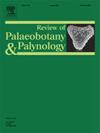蒙古东戈壁盆地中侏罗世植物化石
IF 1.7
3区 地球科学
Q2 PALEONTOLOGY
引用次数: 0
摘要
本文首次报道了蒙古东戈壁盆地Dovtsog Khudag地区Khamarkhoovor组中侏罗世植物化石,共鉴定出苔类、马尾类、蕨类、苏铁类、银杏类、针叶树类、针叶树类等11属20种植物化石。根据沉积学分析和植物组合,将沉积环境解释为冲积平原和沼泽。冲积平原沉积物的特点是银杏植物、苏铁(nilsononia)和针叶树(Pityophyllum)的存在。沼泽环境的特点是捷克诺斯科(捷克诺斯科,Phoenicopsis),马尾(Equisetites)和蕨类(Coniopteris, Cladophlebis)。在植物地层学上最重要的物种是Coniopteris snigirevskiae, Cladophlebis haiburnensis, Cl.;akulovii(蕨类植物),zzekanowskia(亚科)。凤凰花(Subg.;angustifolia Phoenicopsis)。这些植物化石遗迹,结合蒙古侏罗纪沉积盆地以及中国和西伯利亚邻近地区的植物地层学数据,表明所研究的哈马科胡沃组沉积物属于中侏罗世,最有可能是阿勒尼亚-巴约西亚阶段。所研究的植物区系与西伯利亚植物区系相对应,该区系由暖温带元素组成,具有季节性气候波动特征。本文章由计算机程序翻译,如有差异,请以英文原文为准。
Middle Jurassic plant fossils from the East Gobi Basin (Mongolia)
This study presents the first report on Middle Jurassic plant fossils from the Khamarkhoovor Formation, Dovtsog Khudag area, East Gobi Basin, Mongolia. 20 species of fossil plants from 11 genera have been identified, including liverworts, horsetails, ferns, cycadophytes, ginkgophytes, czekanowskialeans and conifers.
Based on sedimentological analysis and plant assemblages, we interpret the depositional environment as alluvial plain and swamp. Alluvial plain deposits are characterised by the presence of ginkgophytes, cycads (Nilssonia) and conifers (Pityophyllum). The swamp environment is characterised by Czekanowskiales (Czekanowskia, Phoenicopsis), horsetails (Equisetites) and ferns (Coniopteris, Cladophlebis).
The most significant species for phytostratigraphy are Coniopteris snigirevskiae, Cladophlebis haiburnensis, Cl. akulovii (ferns), Czekanowskia (Subg. Vachrameevia) teslenkoi, and Phoenicopsis (Subg. Phoenicopsis) angustifolia. The fossil plant remains, combined with published data on the phytostratigraphy of Jurassic sedimentary basins in Mongolia, as well as adjacent regions of China and Siberia, suggest that the studied deposits of the Khamarkhoovor Formation belong to the Middle Jurassic, most likely the Aalenian–Bajocian stages. The studied flora corresponds to the Siberian Floristic Province, which comprises warm-temperate elements and indicates seasonal climatic fluctuations.
求助全文
通过发布文献求助,成功后即可免费获取论文全文。
去求助
来源期刊
CiteScore
3.50
自引率
21.10%
发文量
149
审稿时长
6 months
期刊介绍:
The Review of Palaeobotany and Palynology is an international journal for articles in all fields of palaeobotany and palynology dealing with all groups, ranging from marine palynomorphs to higher land plants. Original contributions and comprehensive review papers should appeal to an international audience. Typical topics include but are not restricted to systematics, evolution, palaeobiology, palaeoecology, biostratigraphy, biochronology, palaeoclimatology, paleogeography, taphonomy, palaeoenvironmental reconstructions, vegetation history, and practical applications of palaeobotany and palynology, e.g. in coal and petroleum geology and archaeology. The journal especially encourages the publication of articles in which palaeobotany and palynology are applied for solving fundamental geological and biological problems as well as innovative and interdisciplinary approaches.

 求助内容:
求助内容: 应助结果提醒方式:
应助结果提醒方式:


